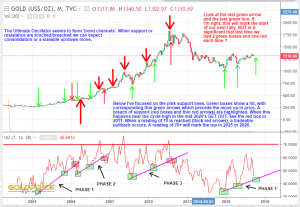Weather And Gold, Surprisingly Similar
Ensemble Forecasting. It’s something we use as a matter of routine to help us forecast what is LIKELY to happen with the weather several days ahead. The way it works is that you take all the known CURRENT weather data (globally). That means current, real time observations of temperature, humidity, air pressure, wind speed and direction and a lot more. Not just at the Earth surface, but all the way up to the top of the atmosphere, using satellite sensing techniques, aircraft data, weather balloon data etc. We then run it through the computer model and project it forwards one hour, 6 hours, 12 hours, 24 hours, a week etc. That gives you one possible future forecast. We then ‘tweak’ the input data,because we have an incomplete picture of current conditions. We don’t have data for every inch of the planet (just wherever the data recording instruments happen to be sited). We then run the model again, and get a different forecast. We do this many times, getting output that shows us all possible future weather outcomes several days ahead. Most of the time the forecast for city X is broadly similar under most of the possible future outcomes, but the further ahead you go, and the more ‘chaotic’ the atmosphere happens to be at the start (during stormy Winter weather for example), the more chance there is that there are several possible future scenarios.
An example might be that out of 100 predictions for London next weekend, we get 70% dry, sunny and cold, 20% warmer with rain, and 10% heavy snow. At that point, we suggest the most likely weather next weekend is dry, sunny and cold, but hint that there is still a degree of uncertainty. The important bit is to run the whole process again 6 hours later and see how the odds have changed, and to keep doing that because confidence levels always increase as the event approaches, and begin to point in the correct direction.
It’s exactly the same with trying to make financial predictions, except, instead of gathering weather observation data, we’re gathering evidence from a massive array of sources (all the indicators I showed you yesterday, plus many more, COT data, bond yields, the dollar, cycle data, interest rates, and so the list goes on). It’s vitally important to learn what it is that each piece of data may, or may not, be telling us. For example, interest rates. Gold can go up or down as rates rise. Real rates are more useful, but you need supporting evidence. It’s no use if only a handful of data is suggesting gold will rise, you need to ‘build a case’. That’s what I’m trying to do. If an indicator is not predictive on its own you need to look where all the others are pointing.
I’m not too concerned with short, or even medium term moves, as long as the long term support line on our new bull holds (somewhere in the low $1200’s). I’m accumulating PM stocks and plan to exit in about 7-8 years time (I may try to time the top after our next move to the $1450-$1550 area and take some profits).
I’ve shown many, many pieces of the jigsaw in my posts – dollar cycle, gold cycle, CHF/USD ratio, real rates, COT, and yesterday, a whole load of indicators. There’s one I haven’t used much in the past – the Ultimate Oscillator. It was developed by Larry Williams, and is a measure of buying or selling pressure. I spent a bit of time looking at how it behaved in the last 20 years or so. The chart is below, with my notes on it. I think it’s worth careful consideration, and is certainly another piece in the puzzle.

Fantastic Work and analogy.
Thanks for the insight into the world of weather forecasting
I am sure all here join me in appreciation for you well thought and balanced studies Northstar
Thanks Fully. I’ve been a bit quiet lately – partly because PM’s are in snoozeville, and partly because work has been crazy. We’ve just had our second bout of icy snow and blizzards in the UK. Weather systems going backwards due to Polar warming a month ago. We got a freezing blast all the way from Siberia.
Excellent NS.
Thank you Northsrar for bringing this to our attention. I look forward to any insights you have concerning this indicator.